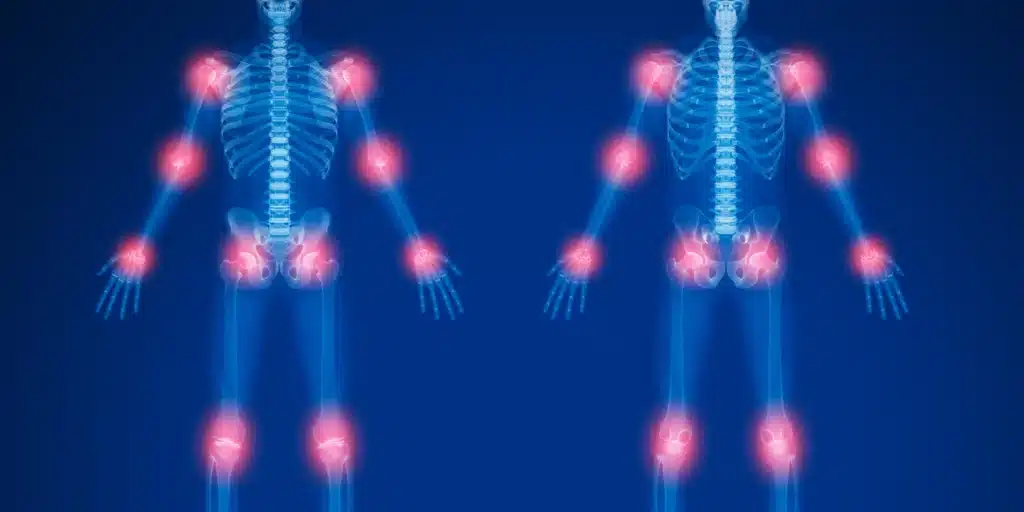|
Getting your Trinity Audio player ready...
|
The Pain of Fibromyalgia
You may have heard about fibromyalgia, but why is fibromyalgia a big deal?
Imagine feeling like you are being stabbed all over the body.
This is what people with severe, untreated fibromyalgia experience all the time.
Fibromyalgia is a chronic pain disorder. It can cause constant full-body pain, exhaustion, sleep problems, memory problems, and even mood issues. It is not curable by medication alone.
The CDC estimates that 4 million US adults suffer from fibromyalgia. That is approximately 2% of the adult population. Women are 2-3 times more likely to develop fibromyalgia than men.
People that live with fibromyalgia can experience significant difficulties with their daily lives.
COVID-19 pandemic had an extreme impact on those living with fibromyalgia. One study reported startling statistics. In people with fibromyalgia:
· 74% experienced difficulties accessing medical resources
· 64% experienced increases in pain
· 78% experienced increases in fatigue
· 74% experienced decreases in quality of life
Fibromyalgia has many complications. In addition to extreme pain, people with fibromyalgia could experience:
· Twice as many hospitalizations as those without fibromyalgia
· Low quality of life
· Depression
· Suicidal Ideation
· Rheumatic diseases like osteoarthritis
People with fibromyalgia might perceive a simple touch, like a light brush of the arm, as extremely painful. Fibromyalgia appears to amplify pain signals to cause overreactions to physical sensations. This causes muscle and joint aches and severe, full-body pain.
Unlike many other chronic diseases, there is not a clear cause of fibromyalgia. This makes fibromyalgia difficult to diagnose. According to a 2020 review, no laboratory tests successfully identify fibromyalgia. Doctors currently rely on questionnaires and patient reports.
There are many theories about why fibromyalgia develops. In this blog, we explore the development of fibromyalgia and how to manage it.
Understanding the Science Behind Fibromyalgia Development

To understand how fibromyalgia develops, you must understand how our bodies sense pain.
Imagine you are getting a shot at the doctor’s office. The needle enters your skin and muscle. That causes pain signals to be sent to the spinal cord through nerves. Then, the signals are sent to the brain via spinal nerves.
According to the Mayo Clinic, both the brain and spinal cord may be processing pain irregularly in patients with fibromyalgia.
One study found pain causes brain activity to be higher in fibromyalgia patients. This study also found that fibromyalgia increases pain sensitivity.
Another study found that pain signaling is different in people with fibromyalgia. Specific chemicals are needed to appropriately respond to pain. With fibromyalgia, these chemicals are at extremely low levels and cause irregular pain signaling.
Now you know how pain is sensed, but why does the irregular pain signaling in fibromyalgia develop?
According to a review published in the American Journal of Medicine, there is no exact cause of fibromyalgia. Several different factors could either cause or sustain fibromyalgia.

- Access the Freedom from Fibromyalgia
Learn from top leaders in the field the skills you need today.
1) Physical Stressors
Physically traumatic events like accidents, abuse, or surgeries can trigger the onset of fibromyalgia.
Specifically, spine or neck injuries were found to be present in 20% of fibromyalgia cases.
Another study found that there were several motions or postures that were linked to developing widespread body pain. These can include:
· Prolonged squatting
· Prolonged working with hands above or at shoulder level
· Repetitive movements of lifting >15 lbs with 1 hand, lifting >24 lbs with 2 hands, or pulling >56 lbs
Under those conditions for one year, 15% of workers reported widespread body pain. Continuing to perform these tasks for long periods of time could lead to the development of fibromyalgia.
2) Psychological Factors & Excessive Emotional Distress
Two psychological factors are common in fibromyalgia patients. These include prolonged grief following death of a loved one (48%) and childhood abuse (40%), according to one study. That study found that 65% of patients experienced a negative life event before the onset of fibromyalgia.
This indicates that excessive stress is a key risk factor for developing fibromyalgia. It is likely that experiencing excessive stress for prolonged periods of time could lead to the inability to regulate stress. Being unable to regulate stress properly was found to be present in patients with fibromyalgia.
3) Genetic Factors
If someone in your family has fibromyalgia, you are more likely to develop it. One study found that in nearly 16,000 pairs of twins with reported chronic pain, genetic factors account for nearly 50% of the occurrences. The genetic influences were not different between men and women.
Further, it was reported that three genes could be involved in the development of fibromyalgia. These genes are involved in the development of serotonin or the development of enzymes that break down stress hormones.
4) Neuroendocrine System Disorder
In people with fibromyalgia, the neuroendocrine system produces high levels of stress hormones. It also does not regulate them well. Specifically, one study found that the hypothalamic-pituitary-adrenal axis did not effectively respond to stress. They also found that baseline levels of cortisol, a stress hormone, were higher in fibromyalgia patients.
5) Autonomic Nervous System Disorder
There appears to be poor autonomic nervous system responses for stress management. Blood pressure responses are poor, and pain inhibition is inadequate. One study found that patients with fibromyalgia do not respond to drops in blood pressure well. They have increased pain when drops in blood pressure occur.
With all these different contributors, it is hard for physicians to treat fibromyalgia. There are many reported ways to treat the pain.
How is Fibromyalgia Treated?
It has been reported that clinical trials have not produced safe and effective drug treatments for fibromyalgia. Only 40-60% of people have been found to have reductions in pain, but the pain is only reduced by 25-40%.
Opioids have been used to treat fibromyalgia. Yet, the significant negative effects may outweigh any potential benefit. Further, addiction to opioids is common and could lead to overdose.
Gabapentinoids are another class of drugs that are prescribed to treat pain conditions, including fibromyalgia. These include pregabalin and gabapentin. However, gabapentin is not FDA approved for fibromyalgia treatment. Like other drug treatments, these have limited effectiveness in treating fibromyalgia.
The cannabinoid system is another target that could reduce pain. Cannabinoid receptors are present throughout the body and are reported to modulate pain sensing. Use of medical marijuana has been reported, but like the other drugs, there are conflicting findings. Self-medication of medical marijuana was found to cause negative psychological effects when used inappropriately.
One study found that a synthetic cannabinoid called nabilone was effective in treating fibromyalgia symptoms. It reduced pain and anxiety while improving quality of life and sleep. Yet, there were adverse side effects including dizziness, drowsiness, dry mouth, and vertigo.
Despite the challenges in finding the right treatment, there are lifestyle modifications that you can make.
Dr. Rodger Murphee is an expert in fibromyalgia management. He and other physicians have found several lifestyle modifications that could work for you.
In the Freedom From Fibromyalgia Summit, you can discover effective lifestyle modifications. The best lifestyle modifications that can be made to manage your symptoms include:
· Modifying your diet
· Stress Management through yoga, breath work, and brain retraining
· Eliminating environmental stressors like mold, toxins, and other pollutants
· Improving sleep
· Reducing inflammation (https://drtalks.com/reversing-inflammaging-summit/)
· Alternative therapies like pulsed electromagnetic field therapy and acupuncture
You can learn more about how to take your life back and free yourself from fibromyalgia at the Freedom From Fibromyalgia Summit.
DrTalks Video Resources on Fibromyalgia
About the Author
Daniel Chantigian, MS, is exploring fibromyalgia. This blog is the first of a three-part series.
- References
- CDC. (2022, May 25). Basic information about fibromyalgia. Centers for Disease Control and Prevention. Read it here.
- Lazaridou, A., Paschali, M., Vilsmark, E. S., Wilkins, T., Napadow, V., & Edwards, R. (2022). The impact of COVID-19 pandemic on mental and physical wellbeing in women with fibromyalgia: a longitudinal mixed-methods study. BMC women’s health, 22(1), 267. Read it here.
- Maffei M. E. (2020). Fibromyalgia: Recent Advances in Diagnosis, Classification, Pharmacotherapy and Alternative Remedies. International journal of molecular sciences, 21(21), 7877. Read it here.
- Mayo Clinic. (2017). Fibromyalgia – symptoms and causes. Mayo Clinic. Read it here.
- Gracely, R. H., Petzke, F., Wolf, J. M., & Clauw, D. J. (2002). Functional magnetic resonance imaging evidence of augmented pain processing in fibromyalgia. Arthritis and rheumatism, 46(5), 1333–1343. Read it here.
- Russell, I. J., Michalek, J. E., Vipraio, G. A., Fletcher, E. M., Javors, M. A., & Bowden, C. A. (1992). Platelet 3H-imipramine uptake receptor density and serum serotonin levels in patients with fibromyalgia/fibrositis syndrome. The Journal of Rheumatology, 19(1), 104–109. Read it here.
- Bradley L. A. (2009). Pathophysiology of fibromyalgia. The American journal of medicine, 122(12 Suppl), S22–S30. Read it here.
- Furness, P. J., Vogt, K., Ashe, S., Taylor, S., Haywood-Small, S., & Lawson, K. (2018). What causes fibromyalgia? An online survey of patient perspectives. Health psychology open, 5(2), 2055102918802683. Read it here.
- Buskila, D., Neumann, L., Vaisberg, G., Alkalay, D., & Wolfe, F. (1997). Increased rates of fibromyalgia following cervical spine injury. A controlled study of 161 cases of traumatic injury. Arthritis and rheumatism, 40(3), 446–452. Read it here.
- Harkness, E. F., Macfarlane, G. J., Nahit, E., Silman, A. J., & McBeth, J. (2004). Mechanical injury and psychosocial factors in the work place predict the onset of widespread body pain: a two-year prospective study among cohorts of newly employed workers. Arthritis and rheumatism, 50(5), 1655–1664. Read it here.
- Anderberg, U. M., Marteinsdottir, I., Theorell, T., & von Knorring, L. (2000). The impact of life events in female patients with fibromyalgia and in female healthy controls. European psychiatry: the journal of the Association of European Psychiatrists, 15(5), 295–301. Read it here.
- Kato, K., Sullivan, P. F., Evengård, B., & Pedersen, N. L. (2006). Importance of genetic influences on chronic widespread pain. Arthritis and rheumatism, 54(5), 1682–1686. Read it here.
- Crofford, L. J., Pillemer, S. R., Kalogeras, K. T., Cash, J. M., Michelson, D., Kling, M. A., Sternberg, E. M., Gold, P. W., Chrousos, G. P., & Wilder, R. L. (1994). Hypothalamic-pituitary-adrenal axis perturbations in patients with fibromyalgia. Arthritis and rheumatism, 37(11), 1583–1592. Read it here.
- Bou-Holaigah, I., Calkins, H., Flynn, J. A., Tunin, C., Chang, H. C., Kan, J. S., & Rowe, P. C. (1997). Provocation of hypotension and pain during upright tilt table testing in adults with fibromyalgia. Clinical and experimental rheumatology, 15(3), 239–246. Read it here.
- Skrabek, R. Q., Galimova, L., Ethans, K., & Perry, D. (2008). Nabilone for the treatment of pain in fibromyalgia. The journal of pain, 9(2), 164–173. Read it here.


